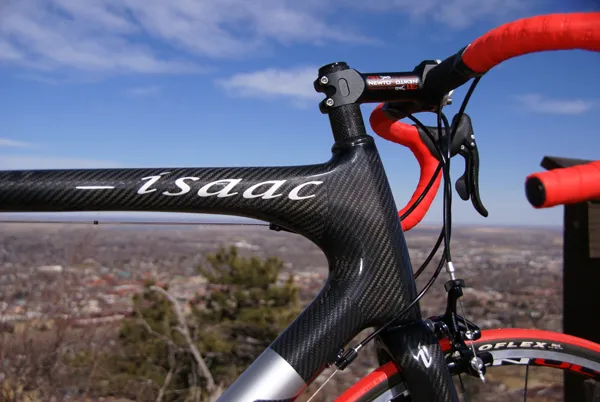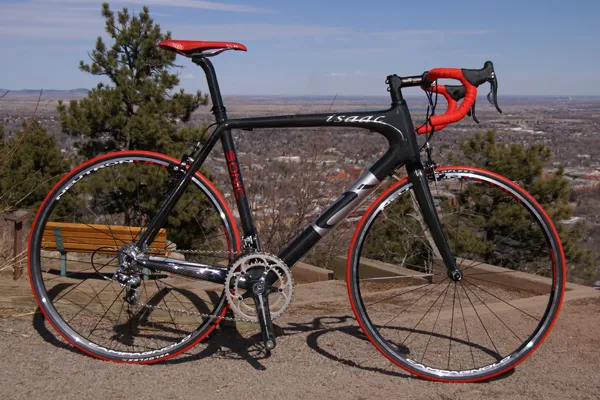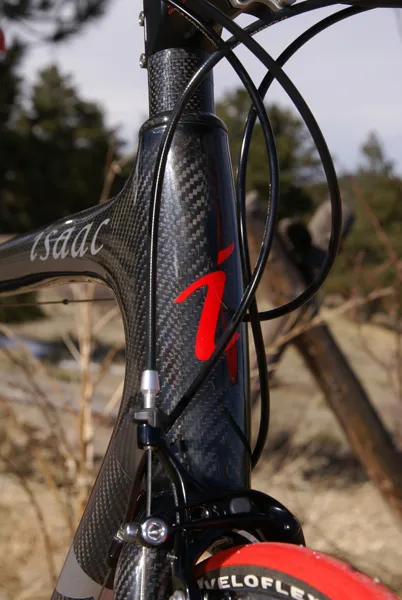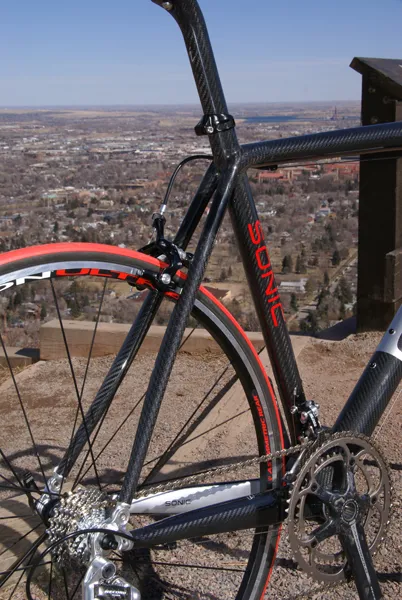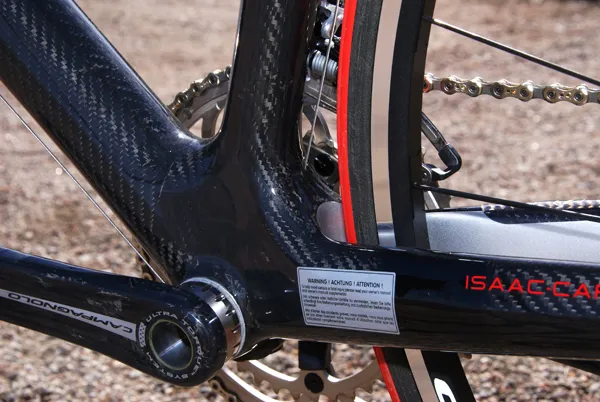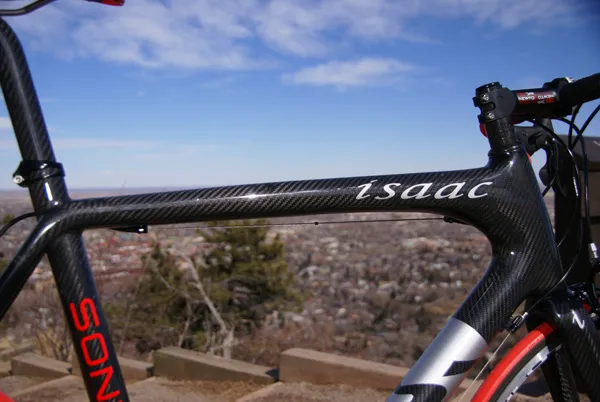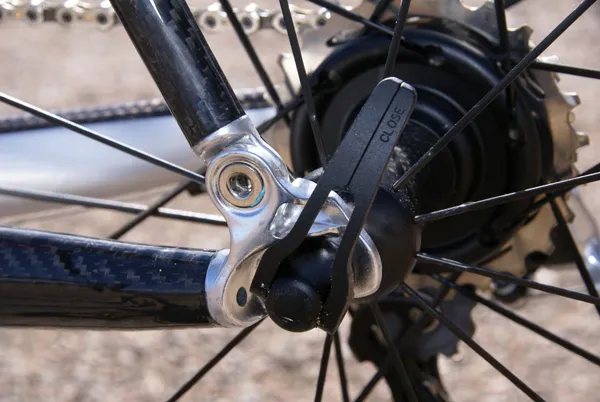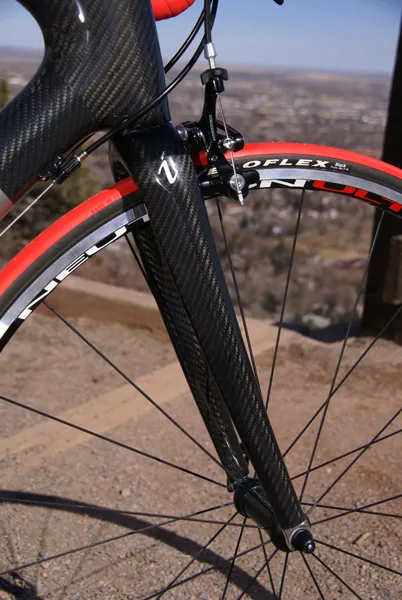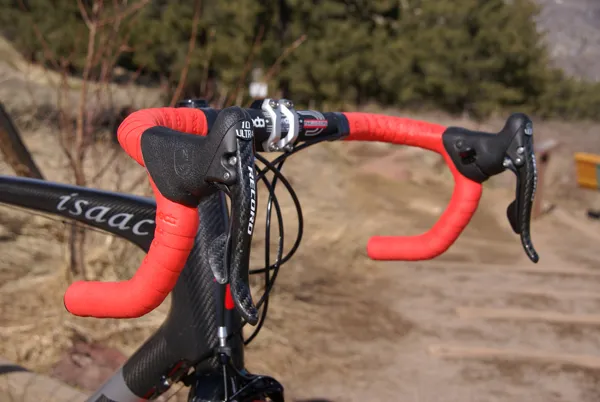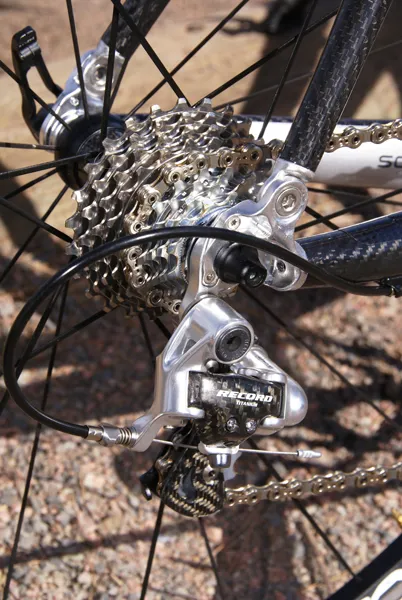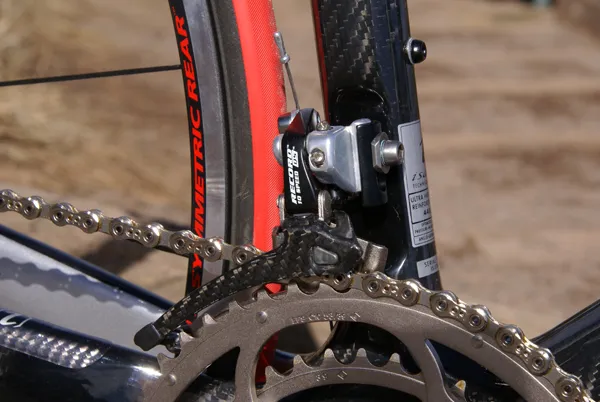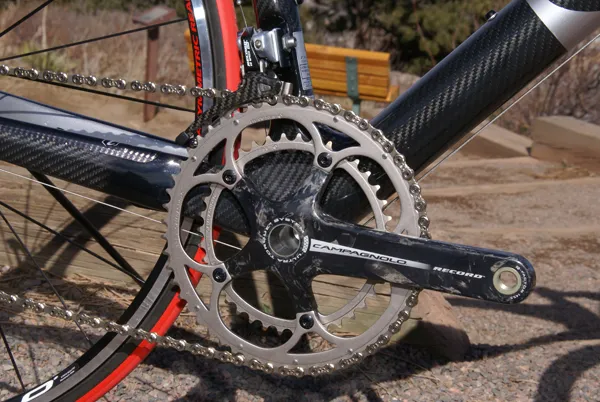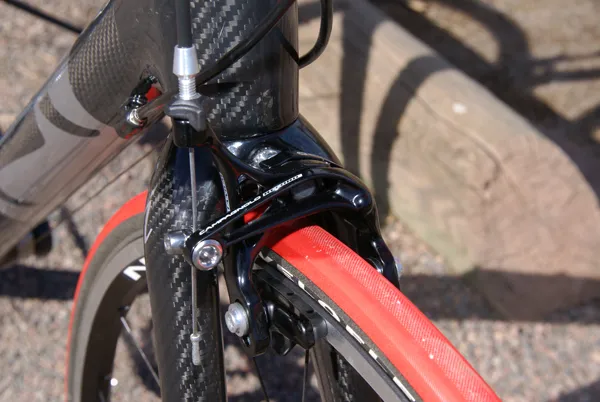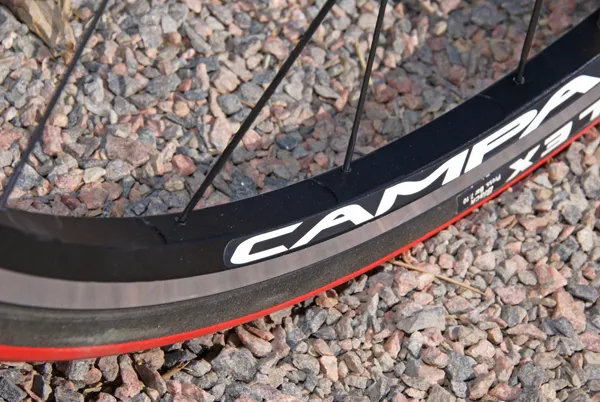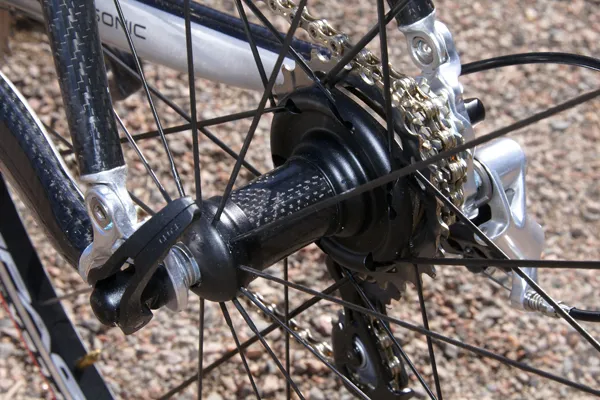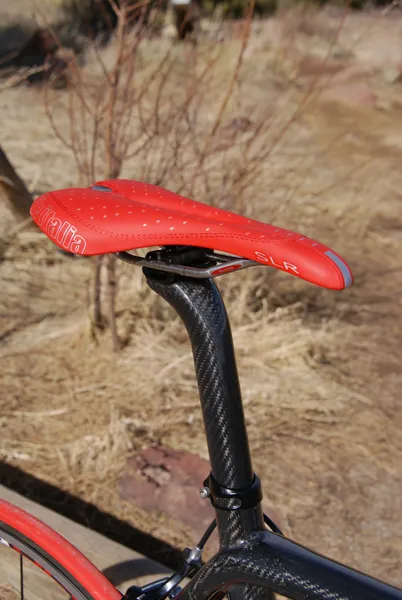Isaac is a German company both in origin and philosophy: precise and meticulous. The Sonic takes those qualities and adopts a third German trait in bike design, the search for uncompromising stiffness. The end result gives back powerfully every Watt you put in, but a bike this rigid isn’t for everyone.
The Isaac Sonic impresses you right out of the box with size: the huge head tube blends into the similarly enormous top tube; the down tube is simply gargantuan; and the chain stays and seat stays are very tall and very wide, respectively. The bare 3k woven top layer is also almost completely unobscured by paint or decals, proudly leaving all of this massiveness of scale for all to see.
Our 57cm sample came equipped with an all-Italian component kit. The subtle graphics and large expanses of carbon were complemented with matching black and red accented parts, creating a sleeper look to this lightweight rocket.
Total as-tested weight was just 6.83kg (15.05lb), without pedals. A bare frame will set you back US$3,199 or UKP1869.99.
The presentation leads to one overwhelming expectation: this bike was going to be stiff. And the Sonic delivers on this promise in a big way.
Ride & handling: total stiffness
The Sonic’s overall ride is one of the stiffest I’ve ever sampled. It reminds me of some track frames: very direct and precise.
Heading uphill, the bike felt rock solid and light while sitting on the tops and spinning in the saddle but getting out of the saddle really let the stiffness shine.
On most bikes a bit of bottom bracket flex almost seems to help smooth out your pedal stroke at moderately powerful cadences out of the saddle as you transition from the power phase to the dead spots. In contrast, the bottom bracket rigidity of the Sonic was so high that that my first attempts out of the saddle were rather choppy.
The solution was to go to a bigger gear and stay on the power a little longer with each pedal stroke which also had the nice side benefit of getting up the climb faster.
The Sonic’s giant front end also provided very precise and trustworthy steering. This was particularly noticeable on some long mountain descents where I typically would have been planted in the drops for more control on some of the high speed switchbacks. On the Sonic, though, I comfortably cruised through some of these corners at 50+kph (30+mph) while still on the tops of the handlebars after only a very short acclimatization period; it truly was that confidence inspiring!
Not surprisingly, the combination of the high drivetrain and front triangle stiffness complemented each other well when sprinting on the flats and holding a tight line in a fast criterium corner. Simply put, the bike goes where you point it very effectively.
But how is all of this stiffness on rough roads, you ask? The Sonic wasn’t exactly forgiving, but it wasn’t as bad as you might expect, either, with the carbon construction damping high frequency vibrations rather well. As it turned out, a proper fit was also even more important than usual in order to get the most out of this bike. Miniscule changes in weight distribution from tweaking the bar height or handlebar rotation have surprising effects on comfort.
Even so, few will ever describe this bike as ‘plush’ but the benefits of the frame rigidity were in no way a limiting factor. It may even alter the way you interact with the bike.
In short, the stiffness of the Sonic is such a huge advantage that the surprisingly small tradeoff in comfort is more than worthwhile. If you are searching for a plush, fair-weather Sunday cruiser of a road bike, though, this one is not for you.
Frame: go big

Beefy downtube
These days there are a number of sub-900g frames (and even ones under 800g) but it still isn’t clear that this race to be the lightest is prudent. The 990g actual frame weight for our 57cm Sonic tester sadly almost qualifies it for middleweight status but based on the ride it seems that those additional grams of carbon and resin are what takes it from ‘too light’ to ‘dead right’.
The Sonic’s extra-large tubing sizes and joints results in a lot of surface area, all of which requires material. Isaac makes up some of the difference by making the tube walls rather thin; they noticeably deflect when squeezed.
Isaac’s hand-laid carbon frames proudly bear the technical specs of their carbon materials.
The frame is first molded in three sections (front triangle, seat stays and chain stays) using up to fifteen unidirectional layers of 440GPa high modulus carbon. The parts are then molded together in the assembly final step.
Isaac also constructs the fork, which uses a tapered steerer measuring 1 1/4in at the crown race and 1 1/8in elsewhere to enhance stiffness. All this carbon engineering is executed precisely in Asia by Martec.
One small niggle with the frame was that the downtube cable stops are mounted such that the housing enters at a harsh angle and rubs the head tube. Frame protecting tape can be added to prevent any marring but moving the stops to the head tube would solve the problem while also making for a more direct cable path.
The front derailleur cable needs to run up though a small hole in the frame after rounding the bottom bracket shell. This is the most direct route because of the massive carbon chain stays but the size of the hole and the proximity to the rear tyre means that this area is frequently dirty. Some cable lube and errant drink mix tends to gum up the hole and the front derailleur cable function suffers as a result.
To be fair, Isaac isn’t the only company to do such a thing but it would be nice to see some sort of seal here as some others are starting to use. Regardless, Sonic owners should factor this into their regular maintenance routine; if not, it will come back to haunt you.
Equipment: Italian form & function
A bike is more than just a frame and fork, and as a mechanic I like the parts that give rise to the whole. The Campagnolo Record group on our tester provided top level performance on par with any of its competitors and the decidedly Italian parts pick served to complement the razor-sharp Sonic both in color and function.
The dual-pivot front/single-pivot rear arrangement on the Record brake calipers has already proven itself to be effective at improving brake modulation but the Sonic’s stiff and direct feel highlighted it even further than usual. There’s plenty of power available in front where you need it while the single-pivot rear caliper reduces the risk of a rear slide in downhill switchbacks, even when approaching at near warp speed.
The Campagnolo Neutron Ultra wheels were a pleasant surprise in an understated way. The box-section hoops were light and smooth-rolling and the freehub mechanism was nearly silent with none of the loud buzzing found on some other hub manufacturers. The spoke holes on the rear rim are also offset for better wheel strength and the simple centered lever and positive cam action of the included skewers work far better than most of what passes as acceptable these days.
One last observation on the wheels is that the Neutron Ultra rims are wider than most and I would hesitate to run a narrow clincher tyre (say, a 700x20c) for fear of the bead unseating. This may also come into play when you add a set of race wheels to the bike or take a neutral spare during an event; you may find that you have to tighten the brake cables to account for the difference in rim widths.
The Veloflex ‘open tubular’ tyres have their roots deep in the Old World. These supple handmade Italian high thread count clinchers create a super smooth tubular-like ride and bear a strong resemblance to similar tyres from Vittoria. The red tread on these tyres helped to cap off the whole bike.
The supplied Deda Newton oversized bar and stem are ProTour proven pieces of equipment that have earned their bulletproof reputation over time. The anatomic bend of the bar may not be for everyone but they work well with the Campagnolo Ergopower levers, placing the controls within close reach. The mechanic in me also trusts the aluminum handlebar in the heat of battle, even if it does give up a few grams to a similar carbon bar.
The Isaac carbon seatpost was nicely crafted and lightweight but the incremental tilt adjustment didn’t offer a fine enough resolution for me; I would have preferred the saddle in between two of the notches. A micro-adjustable seatpost would help in achieving the dialed positioning that this bike demands and would be more fitting of the frame cost.
Summary: benefits of not being the lightest kid on the block
The Sonic is a super stiff, precise and confidence inspiring road assault weapon that perfectly demonstrates the benefit of using a bit more material instead of shooting to be the lightest kid on the block. It may not be overly forgiving, but take some time in getting your position dialed in and you will not be disappointed with the ride.
Rock solid and race ready with the complete Italian parts kit and slightly on the subtle side in appearance, this bike represents an excellent example of the abilities of carbon fiber, carefully engineered, to produce an inspiring bicycle.
